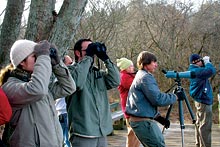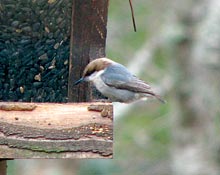“Psst, psst, psst!”
I’m at the Beaver Lake Bird Sanctuary on a freezing February morning with 20 birders from the local Audubon group. Binoculars hang from my neck, and in my hand is a copy of Roger Tory Peterson’s A Field Guide to the Birds of Eastern and Central North America (Houghton Mifflin, 2002). My walking pace is a quarter-mile per hour, at best, and I can’t feel my toes.

From the nearby trees, a brown-headed nuthatch responds to our group leader’s call with a high-pitched sound, reminiscent of a dog’s squeaky toy. According to Peterson, Asheville’s elevation is too high for these little birds, which are more prominent in the Piedmont. But for the past few years, some have been showing up at Beaver Lake.
Our leader, Steve Semanchuk, cracks his field guide open to a map showing the nuthatch’s range. “See how it curves around the mountains?” he asks. “These birds are not supposed to be here. But it’s nice to have them around. As long as there’s a food source, they’ll be here.”
Semanchuk’s interest in birding took flight several years ago when he and his wife, Liz Skiles, began sea-kayaking down on the coast. “When you sea-kayak,” he says, “you see water, sky, marsh and birds—and birds are the only thing that changes.” In time, they brought their interest in birds back with them to Weaverville. These days, the couple travels to places like Mexico, Costa Rica, California and several other Western states in pursuit of sightings.
On this particular morning, though, the birds are in hiding; only hard-core birders are nutty enough to come out and stand around in the 20-degree weather. The boardwalk beneath our feet has a coating of ice, and we can make out raccoon prints on its surface.
I took up birding in New Zealand, where almost every bird was new to me and could be found only in that island nation. I started a list: wekas, tui, bellbirds and keas. And though I continued birding once I returned home, I’m still a rank amateur compared to someone like Semanchuk, who can identify species using only their calls and can distinguish male from female, juvenile from adult.
Birds of a feather

The Elisha Mitchell Audubon Society, the Asheville chapter of the national organization, owns half of the 10-acre Beaver Lake sanctuary and manages the rest under an agreement with the Lake View Park Homeowners Association, which owns the lake. In the 1980s, a developer wanted to build a strip mall where the park is today. After a number of protests, the city and county pitched in to help the local Audubon group buy the land and establish the sanctuary, which it now maintains. Members have erected signs that say “No runners” and “No dogs”—distractions for both birds and birders. Group members also remove invasive plant species when it’s necessary.
But they haven’t cut down all the vegetation around the lake. Birds feel protected by brush and decaying trees, and a certain amount of sloppiness in the landscape, it turns out, is attractive to them.
Other factors also influence bird distribution. For instance, local birders were elated when the water level at Beaver Lake was lowered last summer, because they began seeing more shore birds—white ibises, killdeer, greater yellowlegs, least sandpipers, willets, herons and sora, to name a few—during those species’ fall migration.
Reaching the lakeside, we spot several ruddy ducks bobbing along the water’s surface. They look like rubber duckies in a kid’s bathtub. There are coots, too—chickenlike birds with white beaks that can be spotted at a distance by the way they pump their heads back and forth. The coot has a reputation for orneriness and is known to chase other species around. Some hunters once considered it a pest, hence the expression “old coot.” But despite its questionable rep, the coot is also an important indicator species for the overall health of wetland ecosystems.
In the trees along the lake, a red-bellied woodpecker, the most common kind in the Southeast, is working hard to widen an already substantial hole. Although the bird has a prominent red head, oddly enough it’s named for its belly, which is barely pink. At that point, a rabbit runs out from behind a bush, taking everyone’s attention away from birds for a moment.
Someone spots crows across the lake, circling around the top of a pine, seemingly very agitated. Semanchuk sets up his scope and we take turns gazing through it. A hawk comes into view, sitting peacefully on a distant branch—the likely cause of all this excitement. A hawk’s mere presence is enough to frighten every other bird around.
The birding obsession
Birding may be one of the world’s most competitive outdoor pursuits. There are about 9,000 species of birds all told, and for many, bird watching becomes a compulsion. In To See Every Bird on Earth (Hudson Street Press, 2005), Dan Koeppel writes about his father, Richard, an obsessive birder who gave up his family, friends and career to become a “big lister,” a birder who travels the world compiling lists of his or her sightings. Over the years, the senior Koeppel has spotted more than 7,000 different species, a feat equaled to date by fewer than a dozen others. Birding demands focus, memorization and a near-constant immersion in bird books.
I asked Len Pardue, an officer of the local Audubon chapter, about his birding life. Awhile back, he and his wife lived in a second-floor apartment in Chapel Hill. Their kitchen window looked down on a roof below. Now and again they would scatter bread crumbs from the window, but they didn’t know what birds they were seeing until Pardue’s wife bought him the Golden Guide to Birds (St. Martin’s Press, 2001). One day, they spied something that looked like a sparrow but had a yellow rump. Sure enough, it turned out to be a yellow-rumped warbler.
On one group birding trip where a fellow birder was determined to observe a particular bird. “I stepped in front at a critical moment and blocked his view,” Pardue laments. “He was pretty upset, but fortunately he saw the bird later on the trip.”
These days, says Pardue, he’s a little more relaxed about the hobby. “But the passion is good,” he adds. “It brings out the splendor and variety of birds and the importance of saving bird habitats. Traditionally, birding was dominated by old, wealthy people. It’s wonderful to see young people in birding.”
[Hike leader and outdoors writer Danny Bernstein is the author of Hiking the Carolina Mountains (Milestone Press, 2007). She can be reached at danny@hikertohiker.com]
The Elisha Mitchell Audubon Society sponsors guided bird walks at Beaver Lake on the first Saturday of the month, starting at 9 a.m. (In April, the meeting time will roll back to 8 a.m.) Nonmembers are welcome to attend. Check out all the chapter’s activities at www.main.nc.us/emas/birding.html, or just show up.


Before you comment
The comments section is here to provide a platform for civil dialogue on the issues we face together as a local community. Xpress is committed to offering this platform for all voices, but when the tone of the discussion gets nasty or strays off topic, we believe many people choose not to participate. Xpress editors are determined to moderate comments to ensure a constructive interchange is maintained. All comments judged not to be in keeping with the spirit of civil discourse will be removed and repeat violators will be banned. See here for our terms of service. Thank you for being part of this effort to promote respectful discussion.